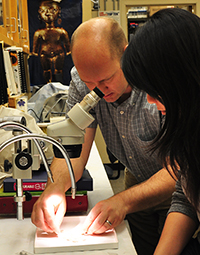Learning by Doing

A discipline preoccupied with societies’ castoff remains, archaeology offers students intimate and corporal interactions with the past that go well beyond the lecture hall. In excavations, they learn to see, feel, and yes, even taste the dirt as they remove it to discover the walls and floors of past societies. And in the laboratory, students clean, repair, illustrate, measure, sift, burn, break, photograph, cut, glue, and more, thousands of objects in order to understand dietary practices, glass manufacturing, and other cultural practices. Given the haptic nature of its techniques, archaeology is, not surprisingly, likened to craftwork. And like all crafts, apprenticeships are opportunities for students to develop their skills. When I was beginning my own career, I spent years of ‘learning by doing’ with scholars who generously taught me, among other things, how to determine the date of a broken ceramic vessel sherd by listening to its ring when dropped on the table. The difference between a bright ‘clink’ and a darker ‘clank’ was 500 years.
Given archaeology’s tradition of apprenticeship, the Geballe Research Opportunities for Undergraduates Program, or G.R.O.U.P, presents a wonderful opportunity to pass along disciplinary knowledge to eager Berkeley students. I recently had the privilege of managing two very different G.R.O.U.P students.
During the summer of 2012, Anthropology undergraduate Hanna Huynh took part in an on-going project to document material ephemera from the floors of ancient houses. Middle Eastern archaeologists often focus on objects that can be easily seen with the naked eye, such as buildings and statues and broken pieces of a ceramic jar. But a closer look reveals that thousands of tiny objects can be overlooked during excavation. Insight into the consumption, discard, and recycling practices of past societies can be lost as a result. Hanna joined my team investigating microdebris—objects smaller than 3 cm—that were found lodged in floors at Dhiban an archaeological site in Jordan where I excavate most summers. The team will be sharing its first results this April at the Society for American Archaeology meetings in Honolulu.
During an earlier program in 2010, I explored the role that archaeologists play, or could play, in the development of archaeotourism economies in the Middle East. Tourists, including notables like Flaubert, Twain and Churchill, have flocked to Middle Eastern ruins since the nineteenth century. Today, Middle Eastern countries manage archaeological sites like Petra and the Giza pyramids to fuel their tourism economies. Near Eastern Studies undergraduate (now alumnus) Bahador Jafarpur and I sought to understand how archaeologists participate in the development of these economies, using Iran and Jordan as case studies. Luckily, Bahador’s knowledge of Persian allowed him to read hard-to-come-by Iranian publications. Bahador later used our results in his senior thesis on the presentation and management of Persepolis, while I am describing results from Jordan in a chapter of a book I am writing about the role of Near Eastern archaeology in the Middle East.
While Bahador’s and Hanna’s participation in these projects was quite different, I believe they both learned the art of scholarly collaboration. Well-designed projects require scholars to use their unique skills in the pursuit of answers to open-ended research questions. Bahador’s ability to read Iranian publications, for example, broadened the scope of our research in a way I could have never done on my own. Collaboration, like many of us know, is not a naturally occurring condition, but must instead be learned and practiced. Effort and patience are needed to maintain the momentum of productive research. These G.R.O.U.P. Apprenticeships provided ample first-hand opportunities for students to discover the joys and rigors of collaboration, a skill they can bring to whatever career path they choose.
Benjamin Porter is Assistant Professor of Near Eastern archaeology in the Near Eastern Studies Department, and a curator of Near Eastern archaeology at the Phoebe A. Hearst Museum of Anthropology.
Faculty Applications for the 2013-2014 G.R.O.U.P. Program are due Monday, February 11. Review fellowship details and and application guidelines here.